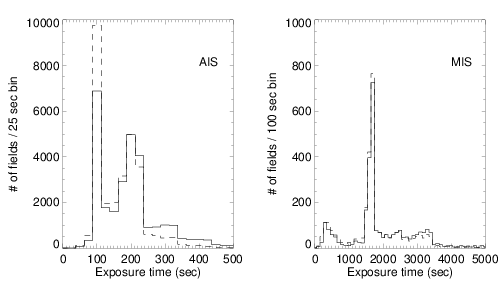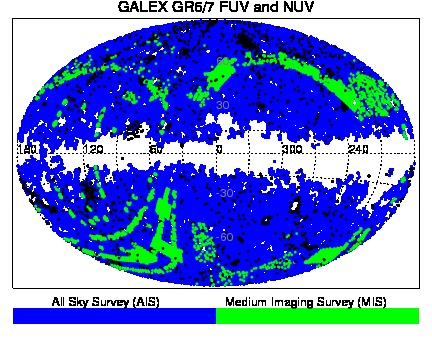|
|||||||||||||||||||
|
|
|||||||||||||||||||
| BCS CAT Home |
Catalog Creation |
Column Descriptions |
SQL CasJobs Access and Examples |
Sky Coverage
A histogram of integration times for tiles used in the BCS AIS and MIS catalogs is found below in Fig. 1. The typical integration time of 150 seconds in the AIS tiles corresponds to limits of 19.9 (FUV_AB) and 20.8 (NUV_AB). The BCS MIS catalog extends down to ~22.7 in both FUV_AB and NUV_AB, for the typical integration time of 1500 seconds. It is important to note that tiles from other surveys, for example, the Nearby Galaxy Survey (NGS) or Guest Investigator (GII), are not included in the BCS catalogs. This decision was made to make the BCS catalogs as homogeneous as possible in terms of limiting magnitude, overall quality, etc.

The decision to exclude tiles from other surveys in the BCS catalogs results in more homogeneous catalogs, but has some ramifications as well. In particular, by excluding the Nearby Galaxy Survey tiles there is reduced coverage around some of the nearest extended galaxies. Also, since many Guest Investigation tiles focused on particularly crowded areas of the sky (galaxies, star clusters), and the GALEX automated pipeline performs somewhat poorly in those regions, such tiles are also excluded. Some of the tiles covering the Large and Small Magellanic Clouds are excluded for similar reasons. Figs. 2 and 3 show the sky coverage of the BCS AIS (blue) and BCS MIS (green) for NUV tiles (Fig. 2) and FUV+NUV tiles (Fig. 3). Regions that are excluded, such as the NGS and GII tiles, the Magellanic Clouds tiles, etc. are in black. Still, the sky coverage is nearly complete outside the Galactic plane for both AIS and MIS catalogs.
Source Selection
Each of the BCS AIS and BCS MIS selected sources using the following criteria and methods, using tiles from their respective GALEX surveys:
- Each source must have both an FUV and NUV observation. I.e., each source must have had both FUV and NUV detectors turned on at the time of observation, but they need not have been detected as a source in both the FUV and NUV.
- Each source must be located within the central 0.5 degree radius of the tile's fiels of view. Significant degradation of fluxes and an increase of artifacts is observed towards the exterior of each tile's field of view, and hence only central sources of a given tile are considered for the BCS catalogs.
- Only sources with errors < 0.5 magnitudes in the NUV are retained. This allows for "NUV-only" sources to be included, along with those that have both FUV and NUV fluxes measured.
- To remove duplicates, all sources located within 2.5" of each other and from different observations (different tiles) are considered duplicates. In those cases, the source from the tile with the longest integration time was kept. For those tiles that had the same integration times, the source that was the closest to its tile's center was chosen.
- When matching FUV sources to NUV sources, a match radius of 3" is used between FUV and NUV sources from the same observation (same tile).
A Note On Crowded Fields and Extended Objects
As noted above, many crowded regions are avoided in the BCS catalog for a variety of reasons. GALEX itself limited its time spent in the Galactic plane due to saturation and crowding concerns. Tiles from the NGS, GII, Magellanic Clouds, and other surveys are excluded. However, there are still tiles that contain dense regions or extended objects, such as galaxies. In those cases, "shredding" of the objects can occur in the automated GALEX pipeline, where regions of peak emission or bright segments of the extended object can be split into numerous sources. When selecting samples, care should be taken when dealing near such crowded regions, like nearby galaxies or star clusters. One method to check for such "shredding" of sources is to download a source of extended galaxies from the hyperLEDA database and checking with BCS catalog sources fall within the confines of those galaxies. When performing global statistical studies using the BCS catalog, it is advised that tiles with such crowded objects be either excluded, or corrected using a careful analysis to detect such "shredding" of extended or crowded objects. Such a concern is lessened when performing source selection using, for example, color-color cuts to find particular types of objects. See Section 3 in the Bianchi et al. 2013 BCS catalog paper for a more detailed discussion.
Matched Catalogs
The BCS catalogs will be cross-matched against the Sloan Digital Sky Survey (SDSS) DR9, Guide Star Catalog II, and PanSTARRS PS1 3π survey. Those catalogs, when available, will be included in CasJobs as separate tables.
Back To Top
|
|
|




 Follow Us
Follow Us
